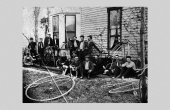How to Read the Land

Landscape smells of the sea. Wading into the ocean on a summer day reveals the essence of landscape. Seaward lie deeper water, surf, riptides and undertow, ocean rollers, and an arc of horizon never still and mocking human control. Landward the beach glows in sunlight, interrupting the storms which sweep sand and dunes and smooth cobbles and boulders. Like the margin between the end of type on a page and the edge of the page itself, every beach is marginal, literally the marge, a limicole zone contested by wilderness and human order. With back to the sea, the wader sees sand and seawalls, as well as cottages and hotels and pathways that are beyond the reach of all but hurricanes and incremental sea level rise. Somewhere in that space lies the ragged edge of what most people too casually dismiss as landscape, the controlled spatial and structural construct, permanent (presuming ceaseless maintenance and continuous renewal), the common built form easily taken for granted, all too easily half seen.

Children upend crenellated pails of wet sand and surround their castles with moats and dikes, roads and walls, but only the youngest presume permanence. Tides come in and swallow. Sometimes children cut gateways in embankments and walls, inviting the flood tide: sometimes they shovel furiously against it, throwing up sand in futile fun. Playing with plastic pails and tiny shovels in sand and salt water and sunlight, they learn what landscape designates, experience directly the making of what essential landscape is.
“Landscape” comes from the old Frisian language of what is now the coast of the Netherlands and the North Sea coast of Germany. Skewed and co-opted by individuals and cohorts with their specialized, narrow interests, the word once meant shoveled land, land thrown up against the sea. Schop is an old word still vibrant in modern Dutch: it means shovel. Seamen introduced landschop to 16th-century alongshore Englishmen who misunderstood or mangled its pronunciation but retained its meaning in landskep, at least for a while.
Of course pail and shovel teach more. The crenellated pail makes conical, rampart-topped castles, one of the oldest icons of order, possession, responsibility, and maintenance, today often topped by fluttering iridescent pinwheels. Its bail demonstrates the ancient rule of path and road making. It is the same length whether lying flat on the pail rim or held upright; but a way curved around a hill tires people and draft animals far less than one aligned over the summit. Rim too is an old word, rooted in the Old Norse rimi and Old English rima meaning a strip of raised land: such strips not only drained better in wet areas but acted as dams or dikes, keeping water in or out. Bail and rim, both curved, reflect the strength of curves: the Old Norse beygla, meaning hoop, produced the English word for horseshoe-shaped things supporting or containing anything (even the necks of oxen) but also a synonym for pail. Medieval Englishmen used bail and pail almost interchangeably, the former term perhaps emphasizing more ordered containment — which is why bailiffs kept order in castles and keep courts in order still, and mariners and attorneys bail out seawater and the arrested. But “pail,” a word rooted in Old English and Old French confusion about measures and pans, meant a hand tool. Bucket connotes a heavier pail used for drawing up water from wells and the sea, usually by winches or windlasses. While English speakers everywhere, and especially Americans, use the two words interchangeably, pail or sand pail prevails on beaches not so much as local usage but from site-specific tradition. Children too weak to carry buckets make do with pails.
Skewed and co-opted by individuals and cohorts with their specialized, narrow interests, “landscape” once meant shoveled land, land thrown up against the sea.
The modern English shovel originates from the same roots as scoop and shove and remains etymologically awkward, but beach toy manufacturers now supply scoops along with shovels and pails, but not yet skips, flat, slab-sided scoops familiar to manufacturers of earth-moving equipment. British English designates the result of shoveling, scooping, and shoving as skips, what Americans call piles. Dumping sand or loam from a pail or truck produces in England a tip, from tip cart, but in America it creates only a pile. Pails and buckets, as well as skips and piles and tips, figure only slightly in the speech and writing of educated people, while lexicographers typically ignore the nuances of such terms in the spoken language of the poor and illiterate. Especially they ignore the terminology and pronunciation of poor people only loosely tied to locale, especially seafarers.
What 16th-century mariners pronounced as “landschop” to uneducated alongshore Englishmen became in time landskap or landskep, then landskip, then landscape. If lexicographers focus on the pronunciation of “landschop” on the coasts of the North Sea, they discover a medieval cultural closeness that other scholars have only glimpsed, one also involving the sophistication of medieval coastal agricultural improvement and the immigration of Frisians into low-lying coastal England. West Frisian proves astoundingly rich in ancient terms still known to farmers and others who work with the soil there but unknown to the Dutch living in Frisia and even to Frisian professionals — yet sometimes known to English farmers. Around 1600, literate Englishmen began writing the word as landskip or landskep to identify paintings representing views across water toward land. Not for decades did it designate scenery pleasing to the eye: first it denoted informational elevations of harbor topography and similar terrain. Late 19th-century German geographers dragged it (and its French near-synonyms) into a conceptual (chiefly political) framework they designated landschaft, something still skewing contemporary scholarly understanding of the term “landscape.” But what children make on the wet sand is the essence of what West Frisians knew as making land, something for which they had a precise vocabulary.
Around 1600, literate Englishmen began writing “landscape” as landskip or landskep to identify paintings representing views across water toward land. Not for decades did it designate scenery pleasing to the eye.
Nomenclature matters, especially on the beach. Landschap, the modern Dutch word that lexicographers assert translates as the English “landscape,” seems to have evolved from landschop. At its seaward edge, “landschop” edges into shelf or shelp, submerged land akin to that made by children shoveling in the thinnest shallows. Lexicographers cannot explain the seeming random variation between p and f in early English, but they know that by the middle of the 16th century shelf designated sandbanks in the sea and in rivers that make water shallow and difficult, sometimes dangerous, to navigate: as Milton knew in 1634, “tawny sands and shelves” were exposed at low tide. Shelp served the same purpose as early as 1430, but somehow also designated plantations of oysters and other shellfish: some writers used scalp and skap in place of “shelp,” suggesting that pronunciation differences indicate different root words. Shelve remains a British dialect term designating the tipping of a tip cart, something resembling the tipping of oyster shells into the water above beds, to increase spawn survival.
Lexicographers wonder at the origin of “shelve” as a standard English verb. They suspect it derives from the West Frisian skelf, an adjective meaning something not quite level or straight: “the land shelves” and similar phrases echo old nuances. Shelving produces potential impediments to navigation, but oysters, mussels, and other shellfish are also shelf fish (shellfish is a term that rewards dredging up), living on shelves sometimes made and typically maintained by fishermen who own, or own the rights to use, the undersea land they shape, the only truly submarine real estate. “Shelf” translates into Dutch as schap.
Especially in law, and particularly in the English common law defining a man’s house as his castle, old real estate terminology — even the term real estate itself — endures unchanged century after century, recorded in deeds and other documents preserved in castles and ordinary county courthouses. Embankment and warping, two coastal words, remain significant but subtle, tripping unwary attorneys and bedeviling any meditative reader of old deeds. Encyclopedias once defined such words in multipage articles. Rees’s “Cyclopaedia”: or, “Universal Dictionary,” the 41-volume, late 18th-century Scottish competitor of the “Britannica,” revised at the beginning of the 19th century in an American edition, defines warping alone in six closely argued pages. Embanking meant raising dikes to keep out the sea or rivers, what Rees understood as sophisticated work; warping out land meant diking and draining fens, saltmarsh, and flats for agricultural use by extending dikes bowed seaward, eventually into the sea, making land from sea bottom, bailing it out, all activity often accomplished in England by Dutch experts. Warp now designates a curve in wood usually caused by damp, but once it also meant the intermittent controlled flooding of warped land, skelf land, what the Dutch call polder, to bring in thin layers of mud deemed useful as fertilizer. “Warp” designates too the heavy lines holding ships to pilings and anchors: on windless days seamen warped sailing ships seaward from piers, winching them from one piling or anchor to another. Determined engineers and farmers warped out land but kept it slightly skelf, so that seepage would drain into the ditches pumped constantly by windmills. They warped in fertilizer, minding dikes and gutters and sluice gates, and worrying constantly about the depredations of great storms and burrowing animals, rats and moles especially. Words matter to anyone looking competently at landscape, especially at dry land once tidal. Especially today.
Cityscape, townscape, streetscape, brainscape, hairscape, cloudscape, airscape, hardscape, bedscape, and other nonce words exist because “landscape” is now a promiscuous word indeed.
The sly and the clever creatively misuse words and torture “landscape” in particular. Cityscape, townscape, streetscape, brainscape, hairscape, cloudscape, airscape, hardscape, bedscape, and other nonce words exist because “landscape” is now a promiscuous word indeed. Its progeny confuse anyone looking around thoughtfully, even at the ocean. In art history circles, seascape designates a concept and image type older than “landscape,” something even young children seem to know when asked which is older, the sea or the land. They look up from their pails and shovels, away from their castles and embankments, walls and gateways, gaze seaward and instinctively know the great age of the sea and the comparative newness of the land. Variable, moody, implacable, unstable, the sea endures beyond shovels and shaping. The built fabric inland from the beach and dunes appears stable, and so beguiles and reassures the thoughtless. It lends itself to advertising hype, to word-making about making and shaping, to expressions like moral landscape and financial landscape, phrases designating things not subject to sudden sea change. Its complexity occludes the very words intended to name its components and facilitate understanding, especially the basic, old words children learn before they learn to read.
Often they learn the word moat from adults helping them build sand castles. A difficult word, “moat.” It vexes lexicographers who suspect its origins in Old French or Celtic synonyms, hill, bank, or dike. Adults think it means the excavated form filled with water, not the raised berm or verge or rim. At the beach, playing in the sun, children learn about shaping land against the sea, the visual iconography of castles and moats and dikes, and even some of the old words, “moat” included.
In a land-centric culture they learn nothing of approaching the beach from the sea, nothing of what mariners call sea state, nothing of the near impossibility of estimating surf height from the sea itself. They learn nothing of estimating distance to horizon, descrying the curve of the horizon, or of looming and other atmospheric phenomena crucial to realizing the world is not flat. They might learn to have fun in boats, but few become intimate with sea language.
In a land-centric culture children learn nothing of approaching the beach from the sea, nothing of what mariners call sea state, nothing of the near impossibility of estimating surf height from the sea itself.
Near the coast, approaching land, making land as seamen still call it, sailing among sandbanks and other shape-shifting hazards, 16th-century North Sea mariners understood “landschop” to mean new-made land warped out into shallows. “Landschop” (or “landschap”) entered English as altumal. (Derived from the Latin altum meaning the deep or the ocean, “altumal” designates the dialect of merchant seamen and shallow-water traders, a sort of mercantile language of the sea, shaping and reshaping coastal dialects. It remains on the marges of lexicography in part because it rarely existed in writing and still retains terms and pronunciations unknown on land. Tackle for example — the blocks, ropes, and cables landsmen refer to as block-and-tackle or fishing tackle — is still pronounced “tay-kel” by older seamen, a pronunciation accepted as “nautical” by a handful of superb dictionaries.) On the low-lying North Sea coasts, especially among the Frisian Islands and inlets, any landschop might be a pilotage hazard: gales shifted sandbanks erratically, but landsmen warping out land might wreck ships and small craft too, if not directly then by diverting currents which move sandbars. Seamen knew every landschop was important in pilotage, especially in storms when each one served as landmark and as hazard to be avoided.
Approaching low-lying sandy land, then and now, involves great skill. Navigation charts typically have offered only plan views useful to deep-sea shipmasters, who expected to pick up local-knowledge pilots off harbors. Most local or pilotage charts still depict shoals and channels sketched from above, often as approximations. Along sandy coasts, shoals and channels wander annually and sometimes more frequently, outdating most charts. Reckoning position proves perilous, even to local fishermen. Coasts devoid of cliffs and hills, indeed of almost any vertical element, confuse, especially in rain, fog, and dark. By the 15th century a few chart makers — and some ship masters sketching their own pilots or rutters — began including sketches of coasts seen in elevation.
Rutter, grounded in the French word routier, meaning a guide to the ways, itself grounded in Old French rote via the later route, is the Frisian, Dutch, and English pronunciation. Away from France, rut skewed routier. Designating a groove worn by cart wheels or a plowed groove or furrow, the term meant then and still means a fixed practice or way of proceeding intended as safe, intentionally neither boring nor exciting. Along rural reaches of British, American, and Canadian coasts, the active listener still hears fishermen speak of rutters, their altumal pronunciation of rudder, the swinging, vertical plane that shapes the course of a boat or ship.
Approaching a low-lying coast, even for small-craft fishermen intimate with it, means knowing the rote of the sea, its roaring soft or loud, still pronounced “rut” in places where “rudder” is “rutter.” Sixteenth-century rutters displaced no pilots, but aided shipmasters regularly calling at low-lying, sandy inlets. Warping out land aided the making of rutters because the land behind the dikes, often land below sea level, required continuous pumping into channels sometimes navigable by small coasting vessels.
Windmills pumped so long as the wind revolved their sails. Netherlands landsmen knew them as icons of triumph, machines keeping salt water at bay, constantly bailing, markers of territory won from the sea by people restless under Spanish sovereignty. From the building of the first windmill late in the 16th century, mariners knew them too as position indicators, especially the grain-milling ones sited atop great dunes. Often sited in pairs and clusters, the vertical forms served as critical seamarks. They became the signature structures of Frisia, Holland, and adjacent low-lying provinces, and in time the signature structures of an independent country, the Netherlands.
Today the pinwheels fluttering atop sand castles announce something forgotten by almost everyone. To the Frisians and Hollanders, then to the Dutch, windmills substituted for castles, rising from low-lying, sandy coasts and heralding the technical expertise, design, and political stability shaping the warping out of land, the making of landschop, the rise of the Dutch republic. Adults buy children pinwheels because pinwheels somehow belong at the beach. They harness wind energy purely for pleasure but they do harness it, alerting smart children to environmental forces shaping sand castles and whatever else people build and sometimes blowing sand into ridges and even dunes. Sandcastles and pinwheels illustrate the political and technical power implicit in the making and maintenance of landscape.
On the summer beach glistens the essential landscape, something any observant, thoughtful individual might ponder. He or she might consider the role of natural forces, the fall of light, the roles of clouds; how blowing sand becomes nuisance, then obnoxious as the wind rises. Maybe the observer wonders about the loss of beach nomenclature in an era devoted to beach recreation and resorts, unmissed terms like guzzle and shingle enabling two people to talk precisely about the ripples in sand exposed at low tide. Or the meditative watcher might wonder at legal concepts, the marge where real estate and the law of the land meet ownerless sea and nautical or admiralty law, where assault-and-battery becomes mutiny. Connected experimenters might carry precious electronic gadgets into the shallows, scrutinizing GPS screens as these shift from map to chart display. More traditional scrutinizers might ponder the distinctions separating landscape imagery, especially painting and photography, from seascapes and marines. Jan van Goyen’s 17th-century “A Windmill by a River” depicts a grain mill atop a great dune overlooking landschop and sea, but Jacob van Ruisdael’s near-contemporaneous “Stormy Sea” depicts a fishing boat desperately aiming for the channel between two parallel rows of pilings guarding a harbor entrance. Most museumgoers viewing the two mid-17th-century Netherlandish paintings easily call the first a “landscape” but hesitate when labeling the second. The former has lots of land and little sea, the second much wild ocean but only two rows of pilings protecting a sandy channel from silting, a vertical daymark, a sailing vessel in peril, and two men standing atop one groin running seaward from sand. Geographers, oceanographers, mariners, and aficionados of pillar mills might see the paintings differently from art history professors and their students, and all experts advance their views ceaselessly, using “landscape” carelessly or in arcane, vested-interest ways which put off inquirers intrigued by larger wholes.
Not every day at the beach shimmers in sunlit museum stillness. Fog changes everything. Fog “comes in” without help from the wind. It keeps vacationers indoors, delays automobile traffic and wrecks airline schedules, misleads walkers (especially at night), plays tricks with sound. Fog changes everything, changes everything viscerally. To know fog at the beach is to know the second cousin of undertow and of great gales and hurricanes alongshore.
To know fog at the beach is to know the second cousin of undertow and of great gales and hurricanes alongshore.
In great storms the determined watcher learns that submarine terrain shapes sand and dunes and even built form inland. A mile or more offshore some ledges break only in century storms: far submerged even at low tide, they reveal themselves when the deepest wave troughs hit them, making surf explode above. As such ledges break — the alongshore word usually designates a fish leaping clear of the water — they break the great rollers which break again on shallow ledges closer inshore. In the aftermath of great storms the observer sees some houses undamaged while those around them are destroyed. Given the identical elevation above and distance from the ordinary tidemark, the pattern puzzles. But the standing houses remain because they are inshore of the deep ledges, within cones of protection; often they are antique, built according to ancient knowledge about the century storms which strike roughly every hundred years, wilderness events revealing ledges that protect built form. Storms remind every observer that natural forces impact what people build. Sometimes storms send observers to shelter, dry clothes, hot coffee, and books about landscape (maybe this one).
In summer sunshine, children and adults ignore books and stand to admire creations shaped from sand. From above they look over land walled against the sea. Such uitgestrektheid land, “land that is overlooked,” means in early Dutch something other than valley land seen from a mountaintop. It means land embanked against the sea, shoveled up in shelves, drained, flat, continually pumped; land easily looked across from the made high ground, the tops of dikes, land taken in with a single long glance often because it seems nearly featureless, punctuated with few if any vertical elements.
Experienced beachgoers scoop a shallow hole in the sand before sitting. A little ergonomic excavation makes sitting easy on the back. After they depart, the barefoot inquirer walking along a deserted beach spies the holes and footprints and realizes what Robinson Crusoe knew, that a footprint means a temporary presence, a hole means a savvy sitter. The holes say a bit more, that someone stopped and shaped and then abandoned the depression to wind and tide. No crumbling sandcastles, no discarded pinwheel, nothing but depressions made by feet and hands … has the inquirer found an abandoned landscape? Well … no.
Start then with looking around.
John R. Stilgoe is Orchard Professor in the History of Landscape at Harvard University, where he has taught for over 40 years. He is the author of many books, including “Old Fields,” “Borderland,” “Outside Lies Magic,” and “What is Landscape?,” from which this article is excerpted.



